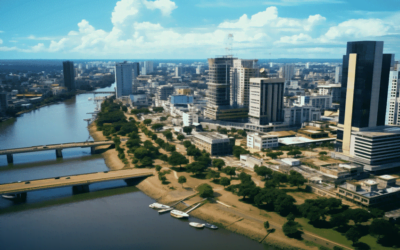Hey there, if you’ve found your way here, chances are you’re as curious about Afghanistan’s drone laws as I was not too long ago. It’s a topic that’s gained quite a bit of interest lately, especially given the recent changes in the region.
I get it; navigating through these legalities can be a bit overwhelming, but fret not, because I’ve got some solid insights to share.
You see, I dug deep into the intricacies of Afghanistan’s drone regulations. The whole burstiness and perplexity of the laws intrigued me. After thorough research, I can confidently say that I’ve got a handle on what you’re likely looking for.
From hobbyist flights to commercial operations, I’ve got the lowdown. So, if you’re eager for the most current and relevant information about Afghanistan’s drone laws, you’re in the right place.
Stick around, because this article is about to be your go-to guide for all things related to flying drones in Afghanistan. Whether you’re a hobbyist looking to capture stunning aerial shots or a commercial operator seeking clarity in a somewhat uncertain landscape, I’ve got you covered.
Trust me, you won’t want to miss out on the insights I’ve gathered. So, let’s dive right in and get you on track to understanding Afghanistan’s drone laws better.
- Pre-Taliban Takeover Regulations
- Post-Taliban Takeover: Uncertain Regulatory Landscape
- Categories of Drone Operators
- Tourist Travel Tips for Afghanistan
- Best Practices and Safety Guidelines for Drone Operation
- Additional Resources and Contacts
- Final Thoughts on Afghanistan Drone Laws
- Frequently Asked Questions (FAQs) on Drone Laws in Afghanistan
Pre-Taliban Takeover Regulations

Before we delve into the current landscape of Afghanistan’s drone laws, it’s essential to understand how things were before the recent political shifts. This period was characterized by specific regulations enforced by the Civil Aviation Authority of Afghanistan (ACAA).
Role of the Civil Aviation Authority of Afghanistan (ACAA)
The ACAA played a pivotal role in overseeing drone operations in Afghanistan. They were the authority responsible for setting guidelines, issuing permits, and ensuring that all aerial activities adhered to safety standards.
Their involvement was crucial in maintaining a sense of order in the airspace, especially as drone usage gained traction among enthusiasts and professionals.
General Rules for Flying Drones
Now, let’s get down to the nitty-gritty of what it meant to operate a drone in Afghanistan before the recent political changes. Understanding these general rules was key for anyone looking to take to the skies with their UAV.
1. Safety Considerations
Safety was paramount. It was stressed that any drone flight had to be executed with utmost caution. This meant meticulously inspecting the equipment, ensuring nothing could possibly fall off during flight, and maintaining a vigilant eye on the surroundings. It’s akin to driving a car: you wouldn’t hit the road without making sure your vehicle was in proper working order, right?
2. Authorization Process
Getting the green light was a must. This involved seeking authorization from the state where the flight was planned. It’s kind of like asking for permission before you step onto someone else’s property – just common courtesy.
This step helped prevent any unforeseen conflicts and ensured that everyone was on the same page.
3. Flight Plan Submission
Think of this as a flight plan you’d submit before taking off on a commercial airline. It’s all about letting the relevant authorities know where you’re going, when, and how you plan to get there. This added an extra layer of safety, ensuring that everyone in the airspace knew who was doing what.
4. Restrictions on High Seas Operations
You’re out on the open sea with your drone, ready to capture some breathtaking shots. However, in Afghanistan, you’d need to coordinate with the appropriate ATS authority.
It’s a bit like letting the Coast Guard know your vessel’s intentions. This ensured that your drone wouldn’t inadvertently wander into airspace where it shouldn’t be. Safety first, always.
This was the landscape before the recent political changes. Now, as things evolve, it’s crucial to keep an eye on any updates and adjustments that may arise in Afghanistan’s drone laws.
Post-Taliban Takeover: Uncertain Regulatory Landscape

Introduction: With the recent changes in Afghanistan’s political landscape, the world of drone regulations has also experienced a notable shift. Let’s dive into the current state of affairs and understand how these changes are affecting drone operators.
Impact of Political Changes on Drone Regulations
The political upheaval in Afghanistan has undoubtedly left a mark on drone regulations. It’s like a sudden change in weather that catches you off guard—you were used to clear skies, but now there’s a storm brewing.
The rules and authorities that once governed drone operations may now be in flux, leaving operators in a state of uncertainty. It’s crucial for drone enthusiasts and professionals alike to stay vigilant and keep an eye out for any official announcements or clarifications regarding the new regulations.
Cautionary Note for Drone Operators
In times of uncertainty, it’s always wise to err on the side of caution. Imagine you’re on a hike, and suddenly, the trail markers disappear. You wouldn’t forge ahead without first assessing the situation, right? Similarly, drone operators in Afghanistan need to exercise prudence. This might mean refraining from flying until there’s clearer guidance on the updated regulations. It’s better to be safe than sorry, especially when it comes to matters of aviation.
Agencies Involved in Regulating Drones (Pre-Taliban)
Before the political changes, the Civil Aviation Authority of Afghanistan (ACAA) played a pivotal role in overseeing drone operations. They were the gatekeepers, ensuring that flights adhered to safety standards and regulations.
However, with the recent shifts in power, it’s unclear how the regulatory landscape will evolve. This uncertainty underscores the importance of keeping a close watch on official announcements and seeking guidance from relevant authorities as the situation unfolds.
Categories of Drone Operators

Alright, let’s break down the drone operators into distinct categories. This will help us understand how different rules apply to different groups, making sure everyone is flying safely and responsibly.
A. Hobbyist Drone Operators
Now, let’s talk about the hobbyists. These are the folks who fly drones for fun, to capture breathtaking shots, or maybe even just to feel the thrill of piloting a UAV. But with the recent changes, there’s a cloud of uncertainty hanging over this category.
1. Uncertainties and Recommendations
For hobbyist drone operators in Afghanistan, there’s a bit of a gray area right now. It’s like trying to play a game without knowing all the rules—you might have some fun, but you also risk stumbling into unexpected obstacles.
That’s why it’s recommended to exercise caution. Until the regulatory landscape stabilizes, consider flying in open, unpopulated areas to minimize potential risks. It’s a bit like choosing a wide, open field for a game of catch—plenty of room to maneuver without any unexpected surprises.
2. Licensing, Registration, and Insurance Status
As of the latest available information, the specifics regarding licensing, registration, and insurance for hobbyist drone operators remain uncertain.
It’s a bit like driving a car without knowing whether you need a license or insurance—you’d want to be cautious and make sure you’re covered in case anything unexpected happens.
Stay tuned for updates from official sources to ensure you’re in compliance with any new requirements that may arise.
B. Commercial Drone Operators
Introduction: Now, let’s shift our focus to the commercial operators. These are the individuals or businesses using drones for professional purposes, whether it’s aerial photography, surveying, or other specialized services.
They have a different set of considerations in the current regulatory landscape.
1. Regulations for Commercial Flights
Commercial drone operations come with their own set of regulations, even before the recent changes. It’s a bit like operating a small business—there are specific permits, licenses, and rules you need to follow to ensure everything runs smoothly.
With the evolving political situation, it’s crucial for commercial operators to stay updated on any new requirements or guidelines that may emerge.
2. Licensing, Registration, and Insurance Status
For commercial drone operators, having the proper licensing, registration, and insurance is paramount. It’s like running a delivery service – you need the right permits, reliable vehicles, and insurance coverage in case of any unforeseen circumstances.
While the specifics may evolve, it’s essential to maintain compliance with any new regulations to continue operating legally and responsibly. Keep an eye on official sources for updates to ensure you’re meeting all requirements.
C. Visitor/Tourist Drone Operators
Introduction: Now, let’s talk about visitors or tourists who might be tempted to capture the stunning Afghan landscapes from the skies. It’s a fantastic idea, but there are some important considerations to keep in mind.
1. Restrictions on Foreign Visitor Flights
For foreign visitors in Afghanistan, flying a drone is a bit like navigating unfamiliar terrain. You want to explore and capture memories, but you must also respect the rules of the land. As of the latest available information, foreign visitor drone flights are not permitted.
It’s akin to visiting a national park; there are areas you’re allowed to explore and others that are off-limits for safety and conservation reasons. While it might be disappointing for travelers, it’s crucial to prioritize safety and compliance.
2. Licensing, Registration, and Insurance Status
In terms of licensing, registration, and insurance, the specifics for foreign visitors remain uncertain. It’s like renting a car in a new country without knowing the exact requirements—you’d want to do your research and make sure you’re meeting all the necessary criteria.
Stay updated with official sources for any changes or clarifications regarding the regulations for foreign visitors flying drones in Afghanistan.
D. Government Drone Operators
Introduction: Government drone operators have a unique role in the airspace. They use drones for various purposes, from surveillance to disaster response. Understanding their permissions and responsibilities is crucial.
1. Permissions for Government Flights
When it comes to government drone operators, permissions are granted based on specific needs and missions. It’s a bit like a specialized unit within a police force—they have the authority to operate in ways that civilians don’t. This ensures that government drones are used for essential purposes, such as national security or disaster management.
2. Licensing, Registration, and Insurance Status
For government drone operators, the requirements for licensing, registration, and insurance may differ from other categories. It’s like working in a high-security facility—there are stringent protocols in place to ensure that operations are carried out with precision and responsibility.
While the specifics may vary, it’s essential for government operators to adhere to any new regulations that may arise and maintain the highest standards of safety and compliance. Keep an eye on official sources for updates to ensure all requirements are met.
Tourist Travel Tips for Afghanistan

Introduction: Alright, let’s switch gears a bit and talk about traveling in Afghanistan. Now, this might not be your typical vacation spot, but for those with a spirit of adventure, it holds a unique appeal. Here are some tips to keep in mind if you’re considering a trip to this captivating country.
Brief Overview of Afghanistan as a Tourist Destination
Afghanistan, often referred to as the “Land of the Afghans,” is a country steeped in history and natural beauty. It’s like a hidden gem, waiting to be discovered by intrepid travelers.
From rugged mountain ranges to ancient cities, there’s a wealth of experience to be had. However, it’s important to note that the country has experienced its share of challenges, and travelers should exercise caution and stay updated on the current situation.
Considerations for Adventurous Travelers
If you’re the adventurous type, Afghanistan offers a unique blend of experiences. It’s like exploring uncharted territory—every turn holds the promise of something new and unexplored.
However, it’s crucial to prioritize safety above all else. Research thoroughly, stay informed about any travel advisories, and consider seeking guidance from local experts or authorities.
Think of it as equipping yourself with the best gear before embarking on a challenging hike—you want to be prepared for whatever comes your way.
Recommended Attractions in Kabul
Kabul, the capital city of Afghanistan, is a place where ancient history meets modern life. It’s like a living museum, with centuries-old landmarks juxtaposed against a bustling urban backdrop.
Some of the recommended attractions include the Eid Gah mosque, the TV tower, and the Darul Aman Palace in the city center. Exploring these sites on a Friday, when it’s a day off in Afghanistan, offers a unique glimpse into the local culture and traditions.
While Kabul’s center is considered relatively safe by Afghan standards, it’s essential to remain vigilant and respect any restricted areas, especially those related to government and military facilities.
Best Practices and Safety Guidelines for Drone Operation

Now, let’s get into the nitty-gritty of operating a drone in Afghanistan. Safety should always be the top priority, especially when dealing with aviation. Here are some essential practices and guidelines to keep in mind for a smooth and secure drone operation.
A. Ensuring Safe Drone Flights
Picture this: You’re about to embark on a cross-country road trip. Before hitting the road, what’s the first thing you do? Ensure your vehicle is in top-notch condition, right? The same principle applies to drones. Before every flight, check your drone thoroughly.
Make sure all systems are functioning and there are no loose components. It’s also crucial to fly in suitable weather conditions; clear skies and mild winds are your best friends.
Avoid flying in adverse weather that might compromise your control over the drone. Safety is about minimizing risks, so always be thorough in your pre-flight checks.
B. Adherence to Authorization Procedures
Imagine you’re at a theme park, and there are specific rules for each ride. To ensure everyone’s safety, those rules must be followed, with no exceptions. Similarly, when it comes to drone operations in Afghanistan, adherence to authorization procedures is non-negotiable.
Always obtain the necessary permissions before taking off. This ensures that your flight aligns with the legal and safety standards set by the authorities. It’s like having a boarding pass before getting on a plane – you wouldn’t take off without it.
C. Compliance with Flight Plan Requirements
Flying a drone without a flight plan is a bit like setting out on a hike without a map. You might have a general direction in mind, but you’re missing crucial details. Before each flight, submit a flight plan to the local aviation authority.
This plan outlines your intended route, duration, and purpose of the flight. It’s like providing your itinerary to a travel companion – it ensures someone knows where you’ll be and for how long. This practice not only adds an extra layer of safety but also helps authorities coordinate airspace usage effectively.
D. Additional Precautions for Unique Afghan Conditions
Afghanistan’s terrain and conditions can be quite distinct from what you might encounter in other regions. It’s like tackling a challenging hiking trail – you’d prepare differently based on the terrain.
In this case, consider factors like high altitudes, extreme temperatures, and potentially rugged landscapes. These elements can affect both your drone’s performance and your ability to control it.
Take extra precautions, such as acclimatizing your drone to the altitude and ensuring you have the right equipment for the environment. Safety isn’t just about following the rules; it’s about being mindful of the specific conditions you’re operating in.
Additional Resources and Contacts

Alright, we’re nearly there! Before we wrap up, let’s make sure you have all the resources you need to navigate Afghanistan’s drone laws smoothly. This section is like your toolkit for any questions or clarifications you might need along the way.
Contact Information for the Civil Aviation Authority of Afghanistan (ACAA)
Imagine you’re on a road trip, and you’ve got a reliable GPS to guide you. In the realm of drone operations in Afghanistan, the ACAA is your GPS. They’re the authority that can provide you with crucial information and address any specific queries you might have.
Should you need to get in touch with them, you can reach out via email at [email protected] or give them a call at +93 20 231 2819. It’s like having a direct line to the experts who can guide you through any uncertainties you might encounter.
B. Recommended Documents and References
Think of this section as your library of essential travel guides. Here, we’ll point you toward key documents and references that can serve as your go-to resources for understanding and adhering to Afghanistan’s drone laws.
These documents are like your trusty travel companions, offering insights and instructions on various aspects of drone operation. They’re there to provide you with clarity and assurance, just like having a knowledgeable friend by your side when you need advice or directions.
In this ever-evolving landscape of drone regulations, having reliable resources and contacts at your fingertips is invaluable. It ensures you’re equipped with the latest information and support, giving you the confidence to explore the skies responsibly and safely.
Final Thoughts on Afghanistan Drone Laws

Alright, we’ve covered quite a bit, haven’t we? Now, as we come to the end of this journey through Afghanistan’s drone laws, let’s take a moment to recap what we’ve learned and why it’s so crucial.
Recap of Key Points
Think of this as the moment you pause at the summit of a mountain, looking back at the trail you’ve conquered. We’ve delved into the regulations set forth by the Civil Aviation Authority of Afghanistan (ACAA).
Remember, these rules aren’t meant to stifle your enthusiasm for drones; they’re here to ensure everyone’s safety and the smooth operation of these incredible flying machines. From the authorization process to flight plans, we’ve covered the essentials you need to know before taking to the skies.
Emphasis on Caution and Adherence to Regulations
Just like any adventure, it’s essential to approach drone flying with a mix of excitement and caution. Adhering to these regulations isn’t just a legal requirement; it’s a commitment to safety and responsible piloting.
It’s akin to strapping on your seatbelt before a car ride – it’s a small action that can make a world of difference. So, as you prepare to embark on your drone adventures in Afghanistan, always keep in mind the importance of following these guidelines.
They’re there to ensure that your flights are not only thrilling but also safe and respectful to all those sharing the skies with you.
With that, my fellow drone enthusiast, you’re now equipped with the knowledge you need to take flight in Afghanistan. Remember, the sky’s the limit, but always with a grounded sense of responsibility and respect for the rules. Happy flying!
Frequently Asked Questions (FAQs) on Drone Laws in Afghanistan
1. Is it legal to fly a drone in Afghanistan?
Yes, flying a drone is legal in Afghanistan. However, there are regulations in place to ensure safe and responsible drone operation. It’s crucial to be aware of and comply with these rules to avoid any legal issues.
2. What are the key regulations for flying a drone in Afghanistan?
The most important rules include obtaining authorization for your flight from the state where you plan to fly, submitting a flight plan to the local aviation authority, and ensuring that your drone flights do not pose a hazard to people, property, or other aircraft. It’s also important to avoid flying over sensitive areas like government or military facilities.
3. Can I fly my drone in Afghanistan without prior coordination over the high seas?
No, you cannot fly your drone over the high seas in Afghanistan without prior coordination with the appropriate ATS Authority. This coordination should be obtained before take-off if there’s a reasonable expectation that your aircraft may enter the relevant airspace.
4. Has the drone regulatory landscape changed after the Taliban takeover in Afghanistan?
The regulatory landscape became uncertain after the Taliban takeover. While the previous regulations and governing agencies existed, it is unclear if they are still in place. It’s essential to exercise caution and seek updated information from Afghanistan-based sources when considering flying a drone in the country.
5. Are there different rules for hobbyist and commercial drone operators in Afghanistan?
As of the available information, the regulations in Afghanistan do not differentiate between hobbyist and commercial drone operators. Both are expected to adhere to the same aviation-based rules. However, it’s important to keep in mind that the regulatory landscape may evolve, so staying informed is key to responsible drone operations in Afghanistan.













